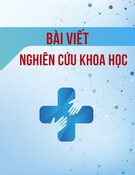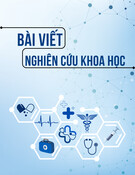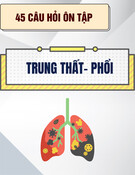
TẠP CHÍ Y häc viÖt nam tẬP 545 - th¸ng 12 - sè 2 - 2024
225
2014; 133(1): 25-9. doi:10.1016/j.thromres.
2013.09.011
2. Kahn SR, Lim W, Dunn AS, et al. Prevention of
VTE in nonsurgical patients: Antithrombotic
Therapy and Prevention of Thrombosis, 9th ed:
American College of Chest Physicians Evidence-
Based Clinical Practice Guidelines. Chest. Feb
2012; 141(2 Suppl):e195S-e226S. doi:10.1378/
chest.11-2296
3. Minet C, Potton L, Bonadona A, et al. Venous
thromboembolism in the ICU: main
characteristics, diagnosis and thromboprophylaxis.
Critical care (London, England). Aug 18 2015;
19(1):287. doi:10.1186/s13054-015-1003-9
4. Morrone D, Morrone V. Acute Pulmonary
Embolism: Focus on the Clinical Picture. Korean
circulation journal. May 2018;48(5):365-381.
doi:10.4070/kcj.2017.0314
5. Stevens SM, Woller SC, Kreuziger LB, et al.
Antithrombotic Therapy for VTE Disease: Second
Update of the CHEST Guideline and Expert Panel
Report. Chest. Dec 2021;160(6):e545-e608. doi:
10.1016/j.chest.2021.07.055
6. Lee MC, Liao CT, Feng IJ, et al. Recurrent
thromboembolism, bleeding, and mortality in
Asian patients with venous thromboembolism
receiving different oral anticoagulants: A
nationwide analysis. Medicine. Sep 16 2022;101
(37):e30412. doi:10.1097/md.0000000000030551
7. Nguyễn Thị Tuyết Mai TTXA, Bùi Thế Dũng,
et al. Đặc điểm lâm sàng, cận lâm sàng và kết
quả điều trị thuyên tắc phổi do huyết khối tại
bệnh viện Đại Học Y Dược thành phố Hồ Chí
Minh. Y học TpHồ Chí Minh. Tạp chí Y học thành
phố Hồ Chí Minh. 2019;23(2):208-213
TỶ LỆ NHIỄM TRÙNG SƠ SINH SỚM Ở TRẺ CÓ MẸ NHIỄM
STREPTOCOCCUS NHÓM B KIỂU HÌNH MLSB CÓ SỬ DỤNG KHÁNG SINH
DỰ PHÒNG LÂY NHIỄM TRƯỚC SINH TẠI BỆNH VIỆN HÙNG VƯƠNG
Nguyễn Thị Thu Sương1, Phan Thị Hằng1, Nguyễn Hữu Trung2
TÓM TẮT56
Mục tiêu nghiên cứu: Xác định tỷ lệ nhiễm
trùng sơ sinh sớm ở trẻ có mẹ nhiễm Streptococcus
nhóm B kiểu hình MLSB đi sinh tại Bệnh viện Hùng
Vương có sử dụng kháng sinh dự phòng lây nhiễm
trước sinh. Phương pháp nghiên cứu: Nghiên cứu
cắt ngang mô tả khảo sát 483 sản phụ nhiễm GBS có
kiểu hình MLSB đi sinh tại bệnh viện Hùng Vương
được sử dụng kháng sinh dự phòng ít nhất 4 giờ trước
khi sinh trong thời gian 01/8/2023 – tháng 31/3/2024.
Kết quả: Nhóm thai phụ ở nhóm tuổi 25 - < 30:
chiếm tỷ lệ cao nhất là 35,61%. Thai kỳ mang GBS có
kiểu hình MLSB có tỷ lệ ối vỡ sớm chiếm 18,84 %.
Ampicillin là kháng sinh được sử dụng thường xuyên
nhất, chiếm tỷ lệ 99,17%. 99,79% thai phụ nhiễm
GBS có kiểu hình MLSB có kết quả kháng sinh đồ nhạy
với kháng sinh ampicillin. Số trẻ sơ sinh bình thường,
không có biểu hiện nhiễm trùng chiếm tỷ lệ (89,86%),
tỷ lệ nhiễm trùng huyết sơ sinh sớm là 10,14% KTC
95% (7,46 - 12,82). Chỉ có 6 trường hợp nhiễm trùng
huyết sơ sinh sớm được chẩn đoán là nhiễm trùng
huyết chắc chắn (Có kết quả cấy máu dương tính)
chiếm tỷ lệ 1,24%. Kết luận: Việc dùng kháng sinh
dự phòng có ý nghĩa làm giảm tỷ lệ lây truyền mẹ con
của GBS, giảm tỷ lệ nhiễm trùng sơ sinh.
Từ khóa:
Streptococcus nhóm B, MLSB, nhiễm
trùng sơ sinh sớm, kháng sinh dự phòng
1Bệnh viện Hùng Vương
2Đại học Y Dược thành phố Hồ Chí Minh
Chịu trách nhiệm chính: Phan Thị Hằng
Email: bshangphan@gmail.com
Ngày nhận bài: 19.9.2024
Ngày phản biện khoa học: 23.10.2024
Ngày duyệt bài: 27.11.2024
SUMMARY
EARLY NEONATAL INFECTION IN INFANTS
BORN TO MOTHERS INFECTED WITH GROUP
B STREPTOCOCCUS PHENOTYPE MLSB USING
ANTIBIOTICS FOR PRENATAL INFECTION
PROPHYLAXIS AT HUNG VUONG HOSPITAL
Objective: The rate of early neonatal infection in
infants whose mothers were infected with group B
Streptococcus with the MLSB phenotype who gave
birth at Hung Vuong Hospital and used antibiotics to
prevent infection before birth. Method: A cross-
sectional study describing a survey of 483 pregnant
women infected with GBS with the MLSB phenotype
who gave birth at Hung Vuong Hospital and used
antibiotics to prevent infection at least 4 hours before
birth during the period from August 1, 2023 to March
31, 2024. Results: Pregnant women aged 25 - < 30
years old: accounted for the highest rate of 35.61%.
Pregnancies with GBS with the MLSB phenotype had a
rate of premature rupture of membranes of 18.84%.
Ampicillin was the most frequently used antibiotic,
accounting for 99.17%. 99.79% of pregnant women
infected with GBS with the MLSB phenotype had
antibiotic susceptibility results to ampicillin. The
number of normal newborns, without signs of infection
accounted for (89.86%), the rate of early neonatal
sepsis was 10.14% CI 95% (7.46 - 12.82). Only 6
cases of early neonatal sepsis were diagnosed as
definite sepsis (with positive blood culture results),
accounting for 1.24%. Conclusion: Prophylactic
antibiotics are effective in reducing the rate of mother-
to-child transmission of GBS and reducing the rate of
neonatal infection.
Keywords:
Group B Streptococcus, MLSB, early
neonatal infection, antibiotic prophylaxis






























